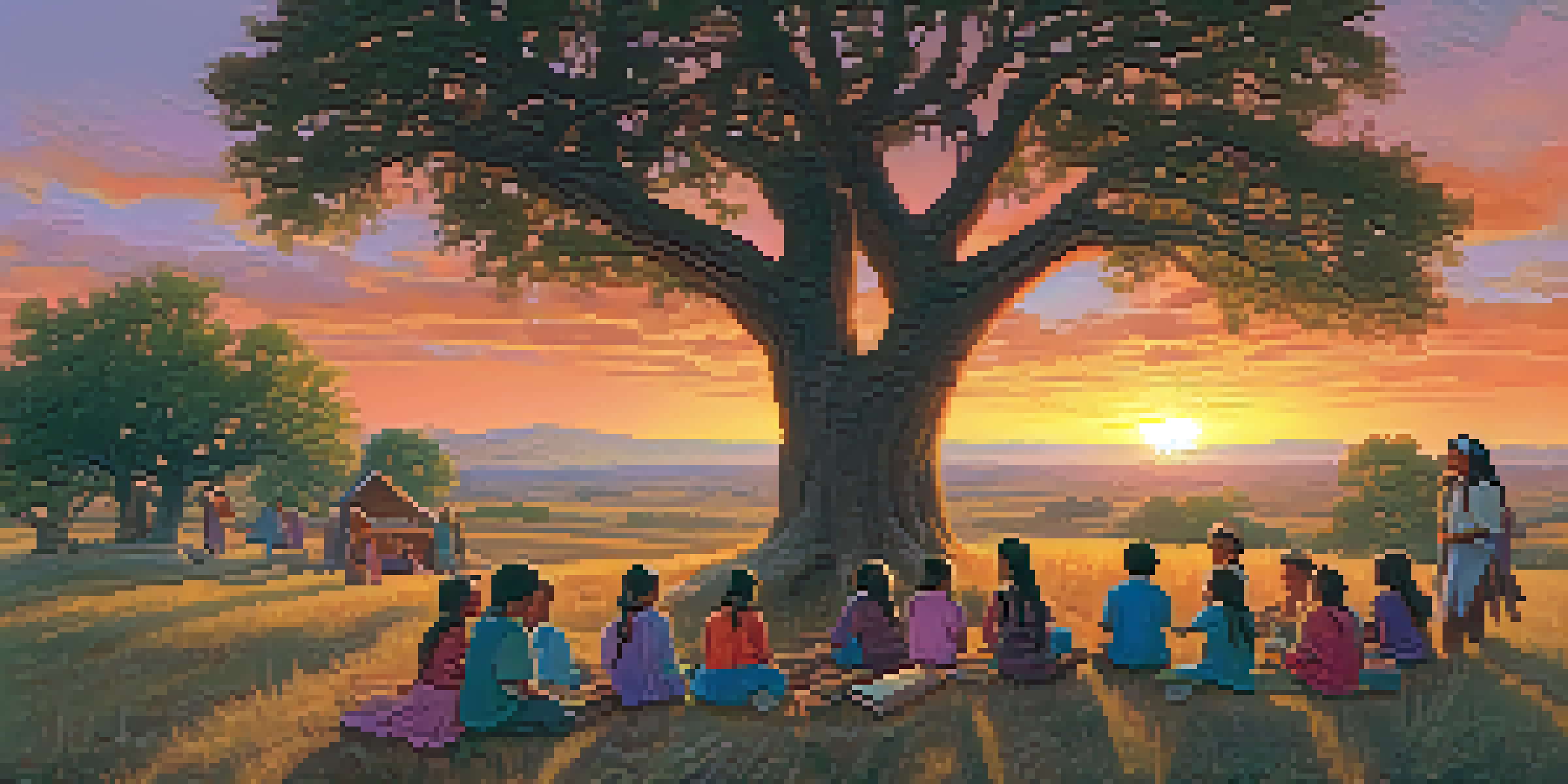Native American Languages and Their Legacy in Kansas

The Historical Context of Native American Languages in Kansas
Native American languages have a rich and diverse history in Kansas, reflecting the myriad tribes that have called this land home. From the Kansa and Osage to the Pawnee and Wichita, each tribe brought its own unique language and cultural heritage. These languages were not merely means of communication but also carried the histories, traditions, and worldviews of the tribes, serving as a vital link to their identity.
Languages are the most powerful instruments of preserving and developing our tangible and intangible heritage.
As European settlers arrived in the 19th century, many Native American languages began to face significant challenges. Colonization efforts, forced removals, and the introduction of English as the dominant language led to a decline in native tongue speakers. This shift not only impacted the communication within communities but also threatened the transmission of cultural knowledge and traditions associated with these languages.
Despite these challenges, many Indigenous communities in Kansas strive to preserve and revitalize their languages today. Language revitalization programs and community efforts aim to teach younger generations their ancestral languages, ensuring that these rich histories and cultural identities continue to thrive.
Key Native American Languages of Kansas
Several Native American languages are historically significant to the state of Kansas. The Kansa language, for example, belongs to the Siouan language family and is a testament to the Kansa tribe's deep-rooted presence in the region. Although the number of fluent speakers has dwindled, efforts continue to document and teach this language, highlighting its cultural importance.

Another notable language is Osage, spoken by the Osage Nation, which originally inhabited parts of Kansas before moving to Oklahoma. The Osage language is rich in symbolism and offers insights into the tribe's worldview, including its spiritual beliefs and connection to nature. Language classes and resources are being developed to ensure that Osage continues to be spoken and celebrated.
Revitalization of Native Languages
Indigenous communities in Kansas are actively working to preserve and revitalize their native languages through various programs and initiatives.
Lastly, the Pawnee language, part of the Caddoan language family, has also made an impact in Kansas. Efforts to revitalize Pawnee include community workshops and educational programs that emphasize its cultural relevance. Each of these languages reflects the unique heritage of their respective tribes and showcases the resilient spirit of Native American communities.
Language Preservation Initiatives in Kansas
In response to the decline of Native American languages, various preservation initiatives have emerged across Kansas. Tribal governments and educational institutions are collaborating to create programs that teach Native languages to both young and older generations. These initiatives not only focus on language skills but also incorporate cultural teachings, fostering a deeper appreciation for heritage.
You can never understand one language until you understand at least two.
One such initiative is the establishment of language immersion schools, where students learn in a Native language environment. This approach immerses learners in the language from a young age, enhancing fluency and cultural understanding. These schools serve as a beacon of hope, demonstrating the effectiveness of engaging youth in their linguistic heritage.
Additionally, community workshops and online resources have been developed to reach a broader audience. By utilizing technology and social media, language advocates can share lessons, materials, and personal stories, making it easier for individuals to access language learning opportunities from anywhere.
The Role of Technology in Language Revitalization
Technology has become a powerful ally in the revitalization of Native American languages in Kansas. Online platforms and mobile apps are being developed to provide interactive language learning tools that cater to various learning styles. This accessibility allows individuals to engage with their heritage in a way that complements their modern lifestyles.
Social media also plays a vital role in connecting language learners and speakers, creating a sense of community around language preservation. Groups dedicated to sharing resources, hosting virtual classes, and celebrating language milestones have emerged, fostering collaboration and support among Native speakers and learners alike.
Cultural Importance of Language
Native American languages encapsulate the identity and cultural heritage of tribes, serving as vital vessels for traditions and worldviews.
Furthermore, digital archives and databases are being created to document and preserve native languages, ensuring that their rich histories are not lost to time. These efforts not only enhance language learning but also promote awareness of the cultural significance of Native American languages.
Cultural Significance of Native American Languages
The cultural significance of Native American languages extends beyond mere words; they encapsulate the identity, beliefs, and values of the tribes. Language serves as a vessel for storytelling, oral traditions, and rituals, conveying knowledge that has been passed down through generations. Each language carries unique concepts and expressions that reflect the tribe's relationship with the land and the natural world.
For instance, many Native languages have specific terms for local flora and fauna, showcasing a deep understanding of the environment. This connection is often absent in English, highlighting the cultural richness embedded within Native languages. By learning these languages, individuals gain insight into the worldviews and philosophies of Indigenous peoples.
Moreover, the revitalization of Native languages fosters pride and empowerment within tribal communities. By reclaiming their languages, Native Americans not only preserve their cultural heritage but also assert their identity in a rapidly changing world. This cultural renaissance is essential for future generations to understand their roots and continue their legacies.
Challenges in Language Revitalization Efforts
Despite the positive strides in language revitalization, challenges remain. One significant barrier is the limited number of fluent speakers, often due to historical suppression of Native languages. As the elder generation passes, the urgency to document and teach these languages becomes more pressing, as fewer people are available to impart knowledge.
Additionally, funding for language programs can be scarce. Many initiatives rely on grants and community support, which can fluctuate over time. This inconsistency can hinder the development of long-term programs that are crucial for sustained language learning and preservation.
Challenges to Language Preservation
Despite positive efforts, the revival of Native languages faces obstacles such as a dwindling number of fluent speakers and funding shortages.
Lastly, the integration of Native languages into mainstream education systems can be complex. Navigating bureaucratic challenges and curricular requirements often poses obstacles for tribes seeking to incorporate their languages into local schools. Overcoming these barriers requires collaboration and advocacy to ensure that Native languages are given the recognition and support they deserve.
The Future of Native American Languages in Kansas
The future of Native American languages in Kansas holds promise, buoyed by the resilience and determination of Indigenous communities. With increasing awareness of the importance of cultural preservation, there's a growing movement to prioritize language learning in both community and educational settings. This shift reflects a broader recognition of the value of linguistic diversity.
Moreover, intergenerational efforts to pass down language skills are gaining momentum, as families and elders play pivotal roles in teaching the younger generation. These grassroots initiatives are crucial, as they foster a sense of belonging and identity among Indigenous youth, connecting them to their heritage in meaningful ways.

As technology continues to evolve, the opportunities for language learning and preservation will only expand. By harnessing digital tools and community support, Native American languages in Kansas can thrive, ensuring that the legacies of these rich cultures endure for generations to come.